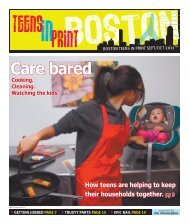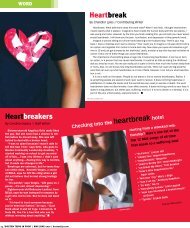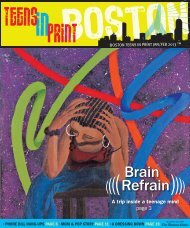“What would you do?” - Teens in Print
“What would you do?” - Teens in Print
“What would you do?” - Teens in Print
- No tags were found...
You also want an ePaper? Increase the reach of your titles
YUMPU automatically turns print PDFs into web optimized ePapers that Google loves.
BOSTON TEENS IN PRINT May/june 2012 <strong>“What</strong> <strong>would</strong><strong>you</strong> <strong>do</strong>?<strong>”</strong>Shoplift<strong>in</strong>gtest caserevealspeople’sprejudicesA special reportBy Alice Xiao, Gerald<strong>in</strong>e Vitt<strong>in</strong>i,Edal<strong>in</strong>a Wang // Staff Writers andMakiz Nasirahmad // Senior EditorA<strong>you</strong>ng, Hispaniclook<strong>in</strong>ggirl strolled <strong>in</strong>to asmall corner store for thefirst time on a recent afternoon,wear<strong>in</strong>g a hoodedsweatshirt and carry<strong>in</strong>ga bag slung over hershoulder.The bodega, <strong>in</strong> a busysection of JamaicaPla<strong>in</strong>, caters to mostlylocal Hispanic adultsand has a loyalclientele.AFH photo by Seijah DrakeCont<strong>in</strong>ued on page 3• CHRIS BROWN REBOUNDS PAGE 10 • ACHY BREAKY HEARTS PAGE 14 • WHITNEY, PRO AND CON Page 20In partnership with
2 / BOSTON TEENS IN PRINT / may/june 2012 / bostontip.com•••••• •••••• Volume★★ContentsPage 4 … T timeFare hikes and dirty vehicles unfair to teens.Page 6 … All decked outCard sharks lose <strong>in</strong> school.Page 7… Flipp<strong>in</strong>g their lidsHats off <strong>in</strong> the classroom.Page 7… Skirt<strong>in</strong>g the issueGirl, are <strong>you</strong> really wear<strong>in</strong>g that to school?Page 11 … R<strong>in</strong>g of truthThe married life as we know it.Page 17… Pet peevesQuit <strong>do</strong>gg<strong>in</strong>’ the <strong>do</strong>gs and cats!★MEET THE STAFF.....12-13AFH photo by Lena Yee46( )Sections17AFH photo by Michelle Nguyencover story........................3transit authority..............4shad<strong>in</strong>g the truth.............5wassup <strong>in</strong> school............6,7gett<strong>in</strong>g personal...............8abroad look.......................9newsstand........................10relationships....................11word.............................14-17stuff..................................18fashion five-O....................19a&e.....................................20The sport<strong>in</strong>g life..............21snark attack....................21tip o’ the hat............... 22,23AFH photo by Bill LeVIII, No. 37Art/PhotographyArtists for HumanitySenior EditorsAshley BarkerTucker S. GayeAlejandro Mart<strong>in</strong>ezMakiz NasirahmadAlicia PerezMelissa RodriguezStaff EditorsShanique LewisMarmar<strong>in</strong> NasirahmadShanae SaddlerStaff WritersLa`Neece ByrdCarol<strong>in</strong>e Dep<strong>in</strong>aTania DuncanRobert H<strong>in</strong>esJose IbarraRalph T. KarnuahNenser KruaOdelyne LamourTaika LamyJalayah LawrenceDennis MembahShamsi MohamedParnian NasirahmadAudrey NgankamSandy NguyenLizandro NogueiraRodrigo SaavedraMussuba SamatiIeisha SampsonJocelyn SantosPenda SeckLucel<strong>in</strong>a SousaGerald<strong>in</strong>e Vitt<strong>in</strong>iEdal<strong>in</strong>a WangAlice XiaoContribut<strong>in</strong>g WritersJoyanne BromeTawndalaya DaRozaLissette DeLeonChandlor LylesSasha NdamTHE BOSTON GLOBERobert M. Powers, AdvisorIrene Mauch, T.i.P. Production DirectorRon Williams, T.i.P. DesignerWRITEBOSTONBetty Southwick, DirectorT.i.P. Coord<strong>in</strong>atorRic Kahn
cover storyCont<strong>in</strong>ued from page 1As the girl surveyed the aisles, <strong>in</strong> walked oneof the regulars, a middle-aged Hispanic womanwith brilliant red hair. When she saw the girlshove a pack of crackers <strong>in</strong>to her bag, thewoman loudly confronted the thief, upbraid<strong>in</strong>gher over and over aga<strong>in</strong> about steal<strong>in</strong>g.“If she were black,<strong>”</strong> the woman later disda<strong>in</strong>fullyexpla<strong>in</strong>ed <strong>in</strong> an <strong>in</strong>terview, “I <strong>would</strong> havegone straight to the manager [rather than approachher directly] because black people likefight<strong>in</strong>g too much.<strong>”</strong>In this case, the assumed crim<strong>in</strong>al was oneof a group of female <strong>Teens</strong> <strong>in</strong> Pr<strong>in</strong>t reportersand associates perform<strong>in</strong>g an experiment. Thisundertak<strong>in</strong>g, conducted over several months,was meant to gauge bystanders’ reactions to<strong>you</strong>ng people of different races – white, black,Asian and one appear<strong>in</strong>g to be Hispanic – whopretended to be shoplift<strong>in</strong>g.With the red-haired lady lead<strong>in</strong>g the way,the results of this test at first glance revealedpeople’s prejudices based only on race. Butjust as <strong>in</strong> the Trayvon Mart<strong>in</strong> case that isunfold<strong>in</strong>g before the nation – and <strong>in</strong> manyother <strong>in</strong>cidents – a deeper look shows a morecomplex set of factors collid<strong>in</strong>g.In the TiP experiment, the outcomes depende<strong>do</strong>n the age, gender, and race of boththe alleged thieves and bystanders, and alsoto what extent the shoplifters and even theobservers were perceived as not be<strong>in</strong>g part ofthe usual customer base.“The <strong>in</strong>dividual will make a judgment call onanother person’s morality based on their ownprejudices,<strong>”</strong> said Laura Hansen, an assistantprofessor of sociology at Western New EnglandUniversity. “People want to simplify theirlives, so they jump to conclusions.<strong>”</strong>The idea for this project, a jo<strong>in</strong>t effortbetween <strong>Teens</strong> <strong>in</strong> Pr<strong>in</strong>t and the New EnglandCenter for Investigative Report<strong>in</strong>g, was<strong>in</strong>spired by the television show “Primetime:What Would You Do?<strong>”</strong> The program attemptsto capture people’s reactions to fabricatedscenarios <strong>in</strong>volv<strong>in</strong>g crimes or ethical dilemmas.For the <strong>Teens</strong> <strong>in</strong> Pr<strong>in</strong>t setup, the owner ofthe bodega agreed to allow his store to beused as the stag<strong>in</strong>g ground. The names of thecustomers – and the store – are be<strong>in</strong>g withheldbecause the circumstances surround<strong>in</strong>gthe shoplift<strong>in</strong>g were contrived.Attract<strong>in</strong>g the most attention from people <strong>in</strong>the bodega was a white teen who appearedto be shoplift<strong>in</strong>g. Half of the six people whowitnessed the purported crime either directlyconfronted the teen or notified the owner.“This surprises me because white peoplehave been seen as the ‘<strong>in</strong>nocent race,’ <strong>”</strong> saidAlison Davey, a sophomore at Boston CommunityLeadership Academy, who is white. “Butthat’s wrong. We’re just like everyone else.<strong>”</strong>Hansen offered another perspective: Shesaid the white teen drew the most repercussionsbecause she stood out <strong>in</strong> an Hispanicneighborhood.“You’re plant<strong>in</strong>g lavender petunias,<strong>”</strong> Hansensaid. “All of a sudden, a white petunia pops up– that’s an anomaly.<strong>”</strong>The two <strong>would</strong>-be shoplifters who attractedthe least response were an Asian and anAfrican-American. In a pre<strong>do</strong>m<strong>in</strong>antly Hispaniccommunity, they were less conspicuous thanthe white teen. Of the observers, only two outof five, or 40 percent, confronted these allegedthieves or alerted the store owner.One elderly Hispanic man at the bodegaoffered this stereotype when <strong>in</strong>terviewed:“Orientals are the most educated people <strong>in</strong>the world. They never take anyth<strong>in</strong>g that’s nottheirs.<strong>”</strong>As for the <strong>in</strong>cident <strong>in</strong>volv<strong>in</strong>g the black shamshoplifter, one Boston student <strong>in</strong>terviewedsaid he expected a larger percentage of thebystanders to react strongly out of ignorance.“I th<strong>in</strong>k there is a racial bias,<strong>”</strong> said J<strong>in</strong>wooChoi, a senior at BCLA.But Hansen has a theory for why so fewpeople did <strong>in</strong>tervene. She, too, believes thatprejudice is at fault, expound<strong>in</strong>g on the redheadedwoman’s rant.“Fear,<strong>”</strong> she said “was [likely] a factor base<strong>do</strong>n stereotypes.<strong>”</strong>In the case of the TiP reporter who appearedto be Hispanic, three of the seven people, or43 percent of those who noticed her pretend<strong>in</strong>gto steal from the store, confronted herdirectly or went to the owner. Many of thosepeople, and other onlookers who reacted tothe team of TiP reporters and associates, knowthe owner personally.“Age, race, familiarity…. There are millionsand millions of layers [that have an <strong>in</strong>fluence],<strong>”</strong>said Hansen. “Prejudice is an attitude, and it isvery difficult to change an attitude.<strong>”</strong>Dur<strong>in</strong>g the trials, the two <strong>you</strong>ngest peoplewho witnessed the pseu<strong>do</strong>-shoplift<strong>in</strong>gs didnot react at all. Both were teenagers. Theirages might have been the reason why theyrema<strong>in</strong>ed silent.“Personally, if it was me,<strong>”</strong> said Choi, who is19, “I <strong>would</strong>n’t say anyth<strong>in</strong>g because it’s notmy bus<strong>in</strong>ess.<strong>”</strong> ■The New England Center for Investigative Report<strong>in</strong>g(necir-bu.org) is a nonprofit newsroom,specializ<strong>in</strong>g <strong>in</strong> <strong>in</strong>vestigative journalism, that isbased at Boston University. NECIR’s collaborationwith <strong>Teens</strong> <strong>in</strong> Pr<strong>in</strong>t is funded by a grantfrom The Hearst Foundations, and is <strong>in</strong>tendedto teach Boston public high school students<strong>in</strong>vestigative report<strong>in</strong>g skills. Also contribut<strong>in</strong>gto this report were Alexandra Burris, an NECIR<strong>in</strong>tern, and Sarah Kuranda, an NECIR teach<strong>in</strong>gassistant.bostontip.com / may/june 2012 / BOSTON TEENS IN PRINT / 3



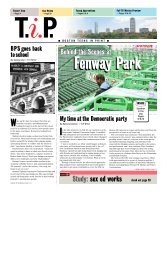
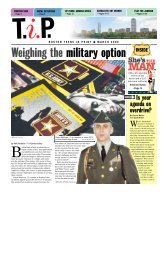

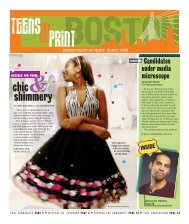
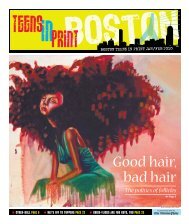


![=bWceh_p_d] j[[d fh[]dWdYo - Teens in Print](https://img.yumpu.com/42327830/1/190x229/bwceh-p-d-jd-fhdwdyo-teens-in-print.jpg?quality=85)

